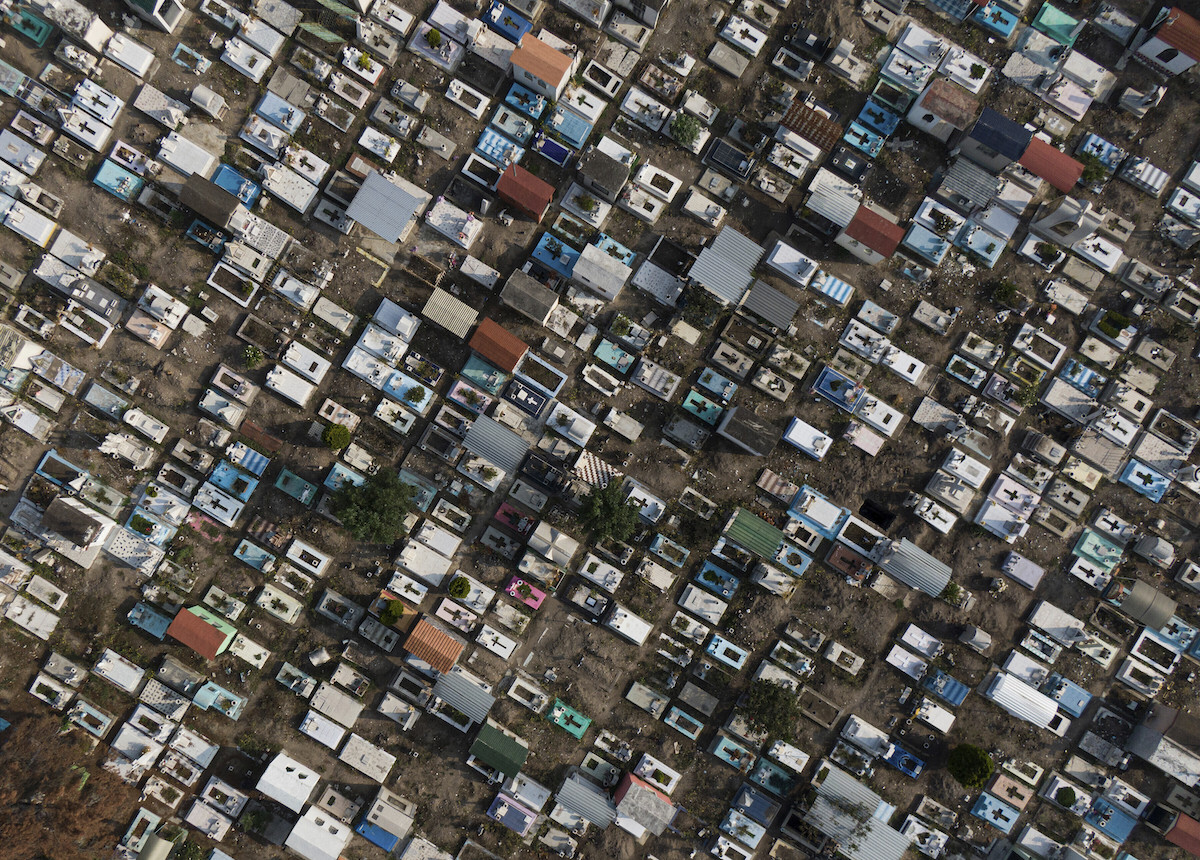

The San Isidro cemetery, that the city’s authorities ordered temporarily closed to the public to keep crowds away as a measure to limit the spread of COVID-19 disease, is seen from the air in Mexico City, Sunday, May 10, 2020. (AP Photo/Fernando Llano)
The climbing death toll of COVID-19 has brought to light an often-overlooked end-of-life ritual among Mexican migrant communities in the U.S.:the repatriation of deceased compatriots from the U.S. to their ancestral homelands in México. Among the many unforeseen tragic consequence of the outbreak, the pandemic is disrupting this long-standing postmortem return migration. Ironically, this immobilization of Mexican migrants in death is symbolic of how they have been excluded in life by the Donald Trump and Andrés Manuel López Obrador (AMLO) administrations on both sides of the border.
As the contagion has careened through the planet —painfully laying bare the racial disparities of public health— newspapers like the Los Angeles Times and The New York Times have paid homage to the migrant victims who have been deprived of a proper posthumous homecoming due to the disease.
“Along with intense emotional anguish and a sudden economic void from the loss of crucial providers, their families must endure another blow,” writes the LA Times about families in México grieving their deceased loved ones in the U.S. “The crisis has made it almost impossible to ship bodies back to Mexico for burial.”
In a similar elegiac tone, the NY Times writes of Mexican migrants who have succumbed to the pandemic in New York City: “For the area’s Mexican immigrants —a community already hit hard by the virus— the pandemic has brought another cruel change. Mexican families typically send bodies home, for flower-strewn Catholic burials, and to give relatives the chance to glimpse their loved ones again after long separations.”
In the wake of COVID-19, the NY Times ominously states, “that sacred rite has come to a halt.”
In my 2019 book Specters of Belonging: The Political Life Cycle of Mexican Migrants, I trace these posthumous repatriations across the México-U.S. border and unearth their political significance for México-U.S. migration. As political scientist Osman Balkan so hauntingly puts it in a different ethno-religious migratory context: “Death in the diaspora also raises existential questions about the meaning of home…the act of burial serves as a means to assert belonging, attachment and…loyalty to a particular group, nation, or place.” The necropolitics of this practice reverberate across international boundaries, for, as Balkan asserts, “Experiences with racism, discrimination, or xenophobia generate a feeling of perpetual foreignness, which follows individuals to the grave.”
Over the decade that I traced these repatriations for the research that went into my book, there were only a handful of media articles on this practice. Some used poetic metaphors, comparing returned deceased migrants to México’s iconic monarch butterflies, that beautiful and powerful symbol of life and cross-border mobility. A 2007 NY Times article discusses the industry that has arisen around this migrant nostalgia market—what I have called a political economy of migrant mourning and melancholia. That article cites aggregate statistics which showed an annual increase in these repatriations.
“Last year, Mexican consulates across the United Sates recorded 10,622 shipments of bodies for burial back home, 7 percent more than in 2005 and 11 percent more than in 2004,” the article from 2007 states.
To flesh out some of these numbers at the subnational level in rural México, I had to dig deep. Plunging into municipal records and local Catholic Church archives, I was able to document over 300 deceased repatriates from diverse places in the U.S. to the migrant-sending municipality of Jerez, Zacatecas. Since the early 1980s, there has been a sustained annual arrival of deceased migrants to this quintessential migrant-sending town and I made it a research ritual to track the Jerez diaspora’s dearly departed who faithfully arrive year after year.
Parsing the local death data reveals some striking patterns. For one, the process seems to be heavily gendered male—roughly 67 percent of the deceased repatriates are male migrants in my case study. The causes of mortality are as diverse as their ages—ranging from natural to violent deaths. Work-related accidents. Homicides. Blunt force injuries. The death certificate data painting a portrait of the precarious life conditions of Mexican migrants under U.S. racial capitalism. Now, we must add COVID-19 to this long list of causes of death. Tragically, the migrants who have fallen to the disease will seemingly remain irrecuperable paisano phantoms for their grieving families back home.
“Tell me how you die and I will tell you who you are,” the Nobel-prize winning Mexican poet Octavio Paz once wrote. A year ago, before most of us could imagine this brave new world that is upon us, AMLO visibly choked up as he addressed his diplomatic corps when he lauded them for the tragic task of repatriating the remains of Mexicans who have died away from the homeland.
Today, the AMLO administration is calling on migrants, including the bodies of those who have succumbed to the pandemic, to remain in the U.S. to avoid further contagion and spread—one of several ways in which AMLO has excluded migrants from his so-called “fourth transformation.”
On the other end of the migrant circuit, Trump has referred to the virus as a “foreign” and “invisible enemy,” precisely the weaponized language that his administration has used to deride migrant communities. As such, the migrant ghosts of the pandemic have become the most haunting reminder of and the perennial specter that will haunt Trump’s right-wing and AMLO’s left-of-center exclusionary migration politics.
***
Adrián Félix is an Assistant Professor of Ethnic Studies at the University of California, Riverside and is the author of the award-winning book Specters of Belonging: The Political Life Cycle of Mexican Migrants (Oxford University Press, 2019).


